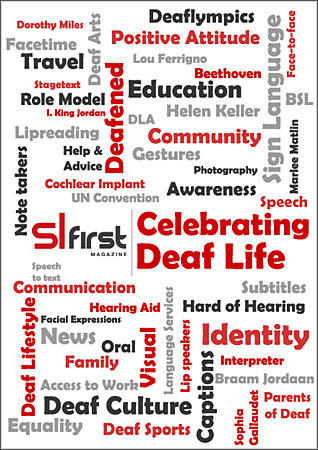Language & Communication1st November 2015
Should we be bothered with BSL linguistics
Concentrating on the rules, there are numerous examples of inaccurate signs every day

Turning to British Sign Language (BSL) late in my life, I am still very much in learning mode, with fluency something I hope will arrive some day soon. For now, my use of BSL is defined by my thinking about what I want to say, translating that in my head and then signing it. Well some of it any way, I don’t have the vocabulary yet to sign everything I want to say. My ambition to learn BSL burns bright, but I am getting a little confused around linguistic rules and the day to day use of the language.
 Let me explain. In addition to signing within the Deaf community, I am also being taught by a fully qualified Deaf teacher. My teacher has been teaching for a while and took time with me to make sure I understood the full nature of BSL as a language, so including use of Non-Manual Features (NMF), nods and shakes, eye gaze, and referencing. We have also spent a lot of time on finger-spelling and finger-spelling patterns, as well as the wider linguistic rules of the langauge, the importance of these, re-stated time and time again.
Let me explain. In addition to signing within the Deaf community, I am also being taught by a fully qualified Deaf teacher. My teacher has been teaching for a while and took time with me to make sure I understood the full nature of BSL as a language, so including use of Non-Manual Features (NMF), nods and shakes, eye gaze, and referencing. We have also spent a lot of time on finger-spelling and finger-spelling patterns, as well as the wider linguistic rules of the langauge, the importance of these, re-stated time and time again.
As my teacher says, “Anything worth building has good foundations, and BSL is no different”.
 I have always valued the quality of the teaching and guidance I have been given, but recently, I have had reason to question whether the strict rules that have been taught and the time and effort I have put into learning them, has been a complete waste of time. I understand that the use of sign language within the deaf community will vary from one person to another and that fluency will mean it looks quite different from the clunky use of signs that I use, but it is the use of BSL videos by examining bodies, teachers and their on-line discussions about linguistics and accuracy of signing, that are causing me confusion.
I have always valued the quality of the teaching and guidance I have been given, but recently, I have had reason to question whether the strict rules that have been taught and the time and effort I have put into learning them, has been a complete waste of time. I understand that the use of sign language within the deaf community will vary from one person to another and that fluency will mean it looks quite different from the clunky use of signs that I use, but it is the use of BSL videos by examining bodies, teachers and their on-line discussions about linguistics and accuracy of signing, that are causing me confusion.
It has left me questioning whether I should bother to learn accurately, because hardly anyone seems to care. Just so long as the meaning of signs can be understood, for example the sign for centre, as in the middle of the town, being used to sign Reading Learning Centre, it doesn’t seem to matter, even though the person using that sign is a BSL teacher.
 For proper nouns, the situation is even more confusing. Apart from some rare exceptions like the sign for London, Sheffield, or a fingerspelling pattern becoming an accepted sign, proper nouns should be finger-spelled shouldn’t they? And yet I see a teacher in the Midlands teaching the sign for wolf, as the sign for Wolverhampton without further explanation. I see the sign for Facebook all the time being hands covering the face and opening up, with the open hands either side of the face, making the book sign. Man and chest being used for Manchester; new and castle for Newcastle; tapping the bottom for Asda; the sign for hungry being used for Hungary; and the sign for pounds in weight passionately argued to be the right sign for pounds in money; and many more. These are just a few examples.
For proper nouns, the situation is even more confusing. Apart from some rare exceptions like the sign for London, Sheffield, or a fingerspelling pattern becoming an accepted sign, proper nouns should be finger-spelled shouldn’t they? And yet I see a teacher in the Midlands teaching the sign for wolf, as the sign for Wolverhampton without further explanation. I see the sign for Facebook all the time being hands covering the face and opening up, with the open hands either side of the face, making the book sign. Man and chest being used for Manchester; new and castle for Newcastle; tapping the bottom for Asda; the sign for hungry being used for Hungary; and the sign for pounds in weight passionately argued to be the right sign for pounds in money; and many more. These are just a few examples.
I started to wonder whether this was a hearing teacher versus Deaf teacher issue, but it’s not, many of the examples of what seems to be a breach of the linguistic rules coming from BSL videos posted by Deaf teachers over social media, YouTube, or elsewhere on the world wide web, and yet no-one seems bothered.
 Taking exams last year, I was faced with exam material that used the sign for bull and ring for The Bullring, rather than fingerspelling it; the centre of somewhere sign, for the name of a Centre; the sign for heavy and rain, for heavy rain, rather than the rain sign with NMF to show it was heavy; and others. If BSL awarding bodies don't get it right in exam material, why should anyone else!
Taking exams last year, I was faced with exam material that used the sign for bull and ring for The Bullring, rather than fingerspelling it; the centre of somewhere sign, for the name of a Centre; the sign for heavy and rain, for heavy rain, rather than the rain sign with NMF to show it was heavy; and others. If BSL awarding bodies don't get it right in exam material, why should anyone else!
Are we as BSL learners to think that signing, shake and spear is OK for Shakespeare; bird and sea is the sign for Swansea; the sign for a physical fight is appropriate for a fight against cancer; the sign for feeling hot is the same for hot water; signing organise when referring to an organisation; that open as in a place being open is right for the British Golf Open. The list is endless every day, of signs that seem to break one or more of the rules of this fabulous language, meaning they are becoming common place.
 Am I wrong to be bothered? Is the meaning of my signing the only thing I should think about, with accurate use of the language now redundant. Are linguistic rules simply consigned to the academic study of BSL, perhaps as part of Deaf History, or are these rules still applicable to use of BSL today.
Am I wrong to be bothered? Is the meaning of my signing the only thing I should think about, with accurate use of the language now redundant. Are linguistic rules simply consigned to the academic study of BSL, perhaps as part of Deaf History, or are these rules still applicable to use of BSL today.
It may be populist to follow suit and use signs that are more akin to mime than the proper BSL sign, or quicker than using proper finger-spelling, but all I want to do, is learn what is right. I’m no longer sure what that is.
Article by BSL Learner
posted in Community / Language & Communication
1st November 2015





